Subject: Digital photos of Nicola/Hedley Pictographs
Tool Used: Field Scanner – a new function of CPP Colour Pixel Plotter
Method: Scan and plot predefined colours without setup
Field Scanner:
By trial and error, and by studying a few pictographs from Nicola/Hedley – as well as some from Baja, Mexico, a set of common (or generic) colours seem to emerge. As a quick check, the Field Scanner was prototyped, in an attempt to serve the following needs :
- as a ‘base formula’ for commonly encountered colours
- to scan colours directly from photo without any setups – no extracting/loading/defining required
- to produce a simple report of colours found
Predefined Colours:
The major colour pigment is ‘Ochre’, which produces ‘Red’, and ‘Clay’. Following the common colour model, the colours modelled are :
- Red : R >> G, R >> B
- Green : G >> B, G >> R
- Blue : B >> R, B >> G
- Yellow : R and G combination
- Cyan : G and B combination
- Magenta : B and R combination
- Black/Grey/Silver/White : R/G/B combination with equal portions of R, G, and B ranges Black(0-90), Grey(60-180), Silver(160-210), White(200-255)
- Beige : Red tinged White
- Clay : Red Clay or Yellow Ochre
- Purple : Red and Blue (Red Ochre on Blue texture Rock)
Test Cases : The three test pit pictograph plus those from Nicola.
Journal of Scans
1. Scan Hedley Pit A Pictograph
Scan/Plot for all predefined colours: 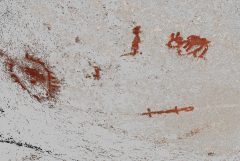
- All 13 predefined colours
- Background Colour Siver-Grey (192,192,192)
- Major colours found :
- beige : average RGB (178 , 171 , 164) Found : 1689806
- clay : average RGB (172 , 161 , 149) Found : 1222185
- red : average RGB (122 , 84 , 71) Found : 1119649
- white : average RGB (198 , 193 , 188) Found : 135783
- Noticed the domination of white/beige/clay
- that can also be the texture/colour of the rock surface
2. Scan Hedley Pit B Pictograph
Scan/Plot for all predefined colours: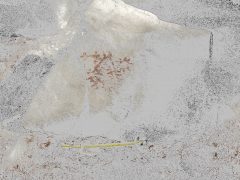
- All 13 predefined colours
- Background Colour Siver-Grey (192,192,192)
- Major colours found :
- beige : average RGB (199 , 194 , 183) Found : 621579
- clay : average RGB (179 , 171 , 152) Found : 563152
- red : average RGB (123 , 97 , 85) Found : 327388
- white : average RGB (220 , 219 , 211) Found : 142614
- Both light/shadow show up clearly
- The Beige/Clay colours strongly suggesting ‘canvas wash’ background
- The ‘clay colour patch rock’ can be identified in front of the measuring tape
3. Scan Hedley Pit C Pictograph
Scan/Plot for all predefined colours: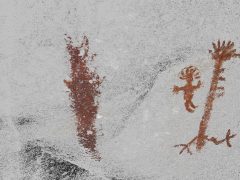
- All 13 predefined colours
- Background Colour Siver-Grey (192,192,192)
- Major colours found :
- beige : average RGB (175 , 170 , 164) Found : 183222
- clay : average RGB (168 , 159 , 146) Found : 84825
- red : average RGB (122 , 83 , 71) Found : 677035
- white : average RGB (202 , 205 , 202) Found : 101544
- The ‘clay wash’ background still noticible (when zoomed)
4. Scan Nicola Fisheye Pictograph
Scan/Plot for all predefined colours: 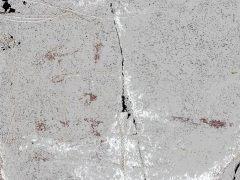
- All 13 predefined colours
- Background Colour Siver-Grey (192,192,192)
- Major colours found :
- beige : average RGB (185 , 180 , 172) Found : 38259
- clay : average RGB (171 , 162 , 146) Found : 28243
- red : average RGB (110 , 85 , 78) Found : 60118
- white : average RGB (231 , 234 , 235) Found : 119475
- magenta : average RGB (133 , 122 , 138) Found : 12818
- The White paint are being pickup – an unusual colour
- With Blue Rock surface – magenta become part of ‘red’ paint
5. Scan Nicola Monck Park Pictograph
Scan/Plot for all predefined colours: 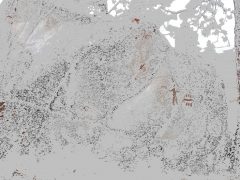
- All 13 predefined colours
- Background Colour Siver-Grey (192,192,192)
- Major colours found :
- beige : average RGB (180 , 174 , 170) Found : 91786
- clay : average RGB (167 , 156 , 146) Found : 19670
- red : average RGB (123 , 97 , 89) Found : 42008
- white : average RGB (233 , 233 , 233) Found : 203517
- The Sky ‘white’ contribute the majority of white pixel
- Combined red/clay clearly define the visible part of figures
6. Scan Nicola Lake Point Pictograph
Scan/Plot for all predefined colours: 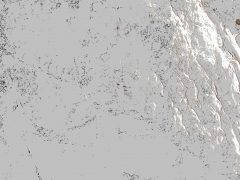
- All 13 predefined colours
- Background Colour Siver-Grey (192,192,192)
- Major colours found :
- beige : average RGB (228 , 223 , 215) Found : 67770
- clay : average RGB (185 , 176 , 157) Found : 32005
- red : average RGB (133 , 102 , 94) Found : 40301
- white : average RGB (246 , 246 , 243) Found : 149224The red patch at right/top corner denotes features that should be studied
- The sun light and casted shadows may hide a pictograph with clay/red
7. Scan Nicola Shakan Eagle Pictograph
Scan/Plot for all predefined colours: 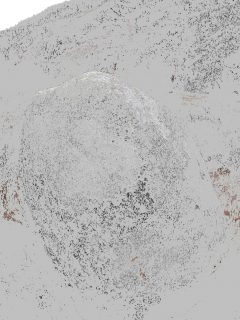
- All 13 predefined colours
- Background Colour Siver-Grey (192,192,192)
- Major colours found :
- beige : average RGB (178 , 173 , 167) Found : 41741
- clay : average RGB (166 , 157 , 142) Found : 17513
- red : average RGB (121 , 99 , 90) Found : 32297
- white : average RGB (225 , 226 , 226) Found : 114872
- Sub-zoning required to find very faint red/clay/purple colours
- Red inside the ‘moss’ should be considered as part of pictograph
8. Scan and Plot Selected colours – Nicola Monck Park Pictograph
Plot for beige/clay/red colours: 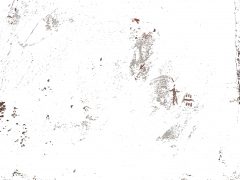
- Scan All 13 predefined colours
- Plot beige/clay/magenta/purple/red ONLY
- Background Colour WHITE (255,255,255)
- Same scan as previous one – except :
- Background changed to white
- Plot only selected colour – as comparsion to a Search Plot
Observations and Comments
Predefined ‘Red’ – generic for all pictographs
The Red defined in the Field Scanner is able to capture sufficient portions of colours for all pictographs to outline its major figures. Consequently, the Field Scanner can be readily employed in the field. Because both Hedley and Nicola Peoples were using the same ‘Ochre’, its usefullness is increased. Now with the same ‘formula’ also incorporated into ‘Define Colour’ and ‘Search Colour’ for Colour Pixel Plotter, it will become the ‘base formula’ for colour specification refinements.
Zoning of Pictograph for Details
By showing where the ‘colours’ are found – the Scanner plotted the pixels where they are spotted – it highlights where the pictograph zones are located. The field team may now choose to take more close-up photos for detailed studies.
Digital Photos as Pictograph Archives
With the Colour Pixel Plotter’s selective plotting and overlay techniques, it can be used to construct detail components as well as composite pictograph archives. These digital records may be stored as Historical Archives and foundation/reference for safe-keeping and study.
Pictograph – an 3D Artefact
Most, if not all, pictographs do not reside on flat surfaces. If they are treated as three-dimensional artefacts, that will greatly facilitate record keeping and project more realistic images. Of course that will demand more ‘scale’ and ‘reference’ when taking the photos; but the pay-off for knowledge gained and subsequent conservation efforts will also be equally rewarding.
Work Notes
Scanner Options:
The Field Scanner will scan the entire photo with built-in 13 colour formulae. After producing the initial plot and report, it will allow a re-scan :
- change the plot background colour (default Silver-Grey(192,192,192)
- the plot option can be turned-off (by erasing the option ‘plot’) for each colour
- the numeric portion of each colour formula can be changed to different values
Transition to Colour Pixel Plotter:
Each colour formula will be prefixed with ‘cpa_’ in the Colour option for CPP. They are encoded in the Colour Spec database and can be selected in ‘Define Colour’ and ‘Search Colour’ functions. So if a colour is found by the Scanner, it can be used directly for searching a pictograph database, or used as a base for refining colour formula.
Using Scanner for quick observations of Nicola/Hedley Pictographs — Raymond Cheng – 2008-07-13